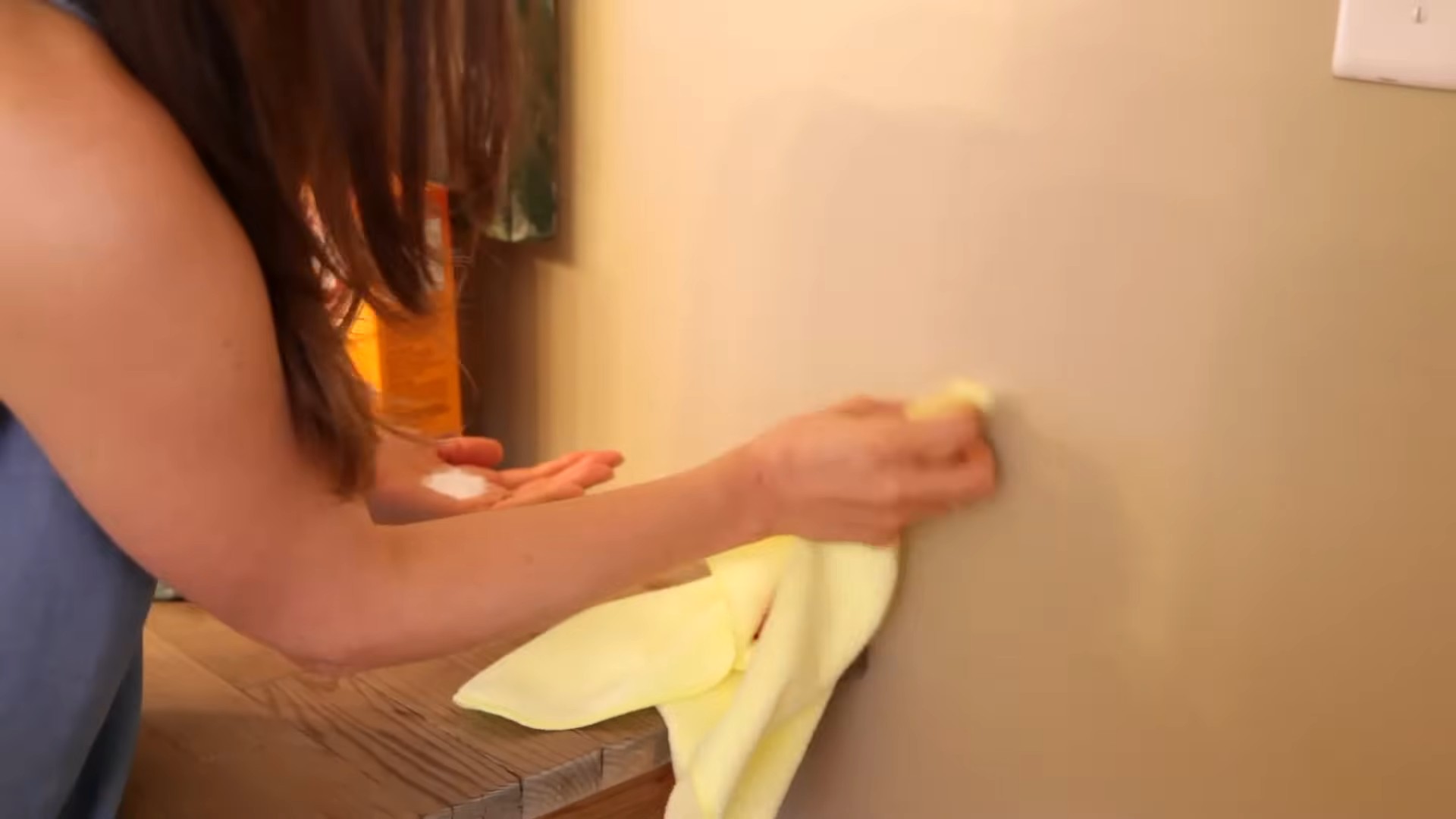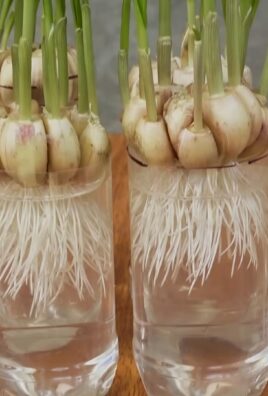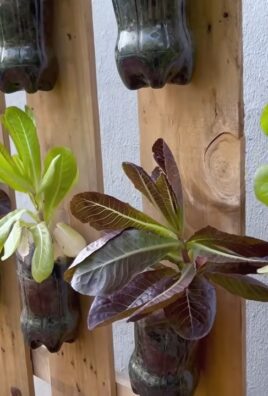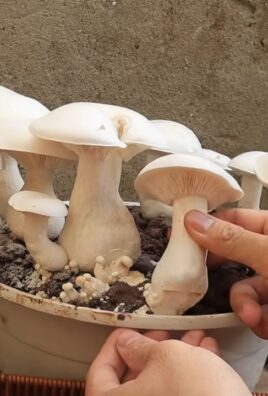Growing Asparagus Indoors might sound like a challenge reserved for seasoned gardeners, but trust me, it’s more achievable (and rewarding!) than you think. Have you ever dreamt of snipping fresh, vibrant asparagus spears right from your kitchen, even when the snow is falling outside? Well, dream no more! This guide is your passport to year-round asparagus goodness, all without stepping foot in a traditional garden.
Asparagus, a delicacy enjoyed for centuries, has a rich history dating back to ancient Greece and Rome, where it was prized for its medicinal properties and unique flavor. While traditionally grown outdoors, modern techniques have opened the door to indoor cultivation, allowing us to enjoy this springtime favorite whenever we please.
Why bother with growing asparagus indoors? Well, for starters, it extends your growing season dramatically. No more waiting for spring! Plus, it’s a fantastic way to control the growing environment, protecting your precious plants from pests and unpredictable weather. Imagine the satisfaction of harvesting your own delicious asparagus, knowing exactly where it came from and how it was grown. I’m here to guide you through every step, from choosing the right variety to providing the perfect growing conditions. Let’s unlock the secrets to successfully growing asparagus indoors and bring a touch of spring into your home, all year round!

Growing Asparagus Indoors: A Comprehensive DIY Guide
Hey there, fellow plant enthusiasts! Ever dreamt of harvesting your own fresh asparagus spears, even without a sprawling garden? Well, dream no more! I’m going to walk you through the surprisingly achievable process of growing asparagus indoors. It takes patience, but the reward of homegrown asparagus in the middle of winter is totally worth it.
Understanding Asparagus and Indoor Growing
Before we dive in, let’s understand what we’re dealing with. Asparagus is a perennial plant, meaning it lives for many years. Outdoors, it goes dormant in the winter and re-emerges in the spring. Indoors, we can mimic these conditions, though it requires a bit of planning. The key is providing a dormant period to ensure healthy growth.
Here’s a breakdown of what you’ll need and what to expect:
* Patience is Key: Asparagus takes time to mature. Don’t expect a huge harvest in the first year.
* Light Requirements: Asparagus needs a lot of light. A sunny south-facing window is ideal, but supplemental grow lights are often necessary, especially during winter.
* Dormancy Period: This is crucial for asparagus health. We’ll simulate winter by withholding water and letting the fronds die back.
* Crowns vs. Seeds: We’ll be starting with asparagus crowns, which are one-year-old plants. This gives us a head start compared to starting from seed.
* Space Considerations: Asparagus needs a large container to accommodate its extensive root system.
Materials You’ll Need
Alright, let’s gather our supplies. Here’s what you’ll need to get started:
* Asparagus Crowns: Purchase one-year-old asparagus crowns from a reputable nursery. I recommend ‘Jersey Knight’ or ‘Purple Passion’ varieties, as they are known for their good yields.
* Large Container: You’ll need a container that’s at least 12 inches deep and 12 inches wide per crown. A larger container is always better! Make sure it has drainage holes.
* High-Quality Potting Mix: Use a well-draining potting mix. A mix of peat moss, perlite, and vermiculite works well. You can also add some compost for extra nutrients.
* Grow Lights (Optional but Recommended): If you don’t have a very sunny window, invest in some grow lights. LED grow lights are energy-efficient and work great.
* Watering Can or Hose: For watering your asparagus.
* Fertilizer: A balanced, slow-release fertilizer is ideal. Look for a fertilizer with an NPK ratio of around 10-10-10.
* Mulch (Optional): Mulch helps retain moisture and suppress weeds. Straw or wood chips work well.
* Gardening Gloves: To protect your hands.
Planting Your Asparagus Crowns
Now for the fun part – planting! Follow these steps carefully to give your asparagus crowns the best start:
1. Prepare the Container: Fill the container about halfway with your potting mix.
2. Create a Mound: Create a small mound of soil in the center of the container. This is where the crown will sit.
3. Position the Crown: Place the asparagus crown on top of the mound, spreading the roots out around it.
4. Cover the Crown: Gently cover the crown with potting mix, leaving the tips of the buds (the “eyes”) just barely exposed.
5. Water Thoroughly: Water the container thoroughly until water drains out of the drainage holes.
6. Add Mulch (Optional): Add a layer of mulch around the base of the plant to help retain moisture.
Caring for Your Asparagus
Once your asparagus is planted, it’s time to provide the care it needs to thrive.
1. Light: Place the container in a location that receives at least 6-8 hours of direct sunlight per day. If you’re using grow lights, position them about 6-12 inches above the plant.
2. Watering: Water regularly, keeping the soil consistently moist but not soggy. Allow the top inch of soil to dry out between waterings.
3. Fertilizing: Fertilize every 4-6 weeks with a balanced, slow-release fertilizer. Follow the instructions on the fertilizer package.
4. Weeding: Keep the container free of weeds.
5. Support: As the asparagus fronds grow, they may need some support. You can use stakes or a trellis to keep them upright.
The Dormancy Period: Simulating Winter
This is a crucial step for healthy asparagus growth. We need to give the plant a rest period to replenish its energy reserves.
1. Stop Fertilizing: In the fall (around October or November), stop fertilizing the asparagus.
2. Reduce Watering: Gradually reduce watering, allowing the soil to dry out more between waterings.
3. Allow Fronds to Die Back: The fronds will eventually turn yellow and die back. This is normal.
4. Cut Back the Fronds: Once the fronds are completely dead, cut them back to the soil level.
5. Move to a Cool, Dark Place: Move the container to a cool, dark place, such as a basement or garage. The temperature should be between 40-50°F (4-10°C).
6. Withhold Water: Do not water the asparagus during the dormancy period.
7. Dormancy Duration: Keep the asparagus in dormancy for about 2-3 months.
Bringing Asparagus Back to Life
After the dormancy period, it’s time to wake up your asparagus!
1. Move to a Sunny Location: Move the container back to its sunny location.
2. Water Thoroughly: Water the container thoroughly.
3. Resume Fertilizing: Resume fertilizing every 4-6 weeks.
4. Watch for New Growth: New shoots will emerge from the soil. These are the asparagus spears!
Harvesting Your Asparagus
This is what we’ve been waiting for! But remember, patience is key.
1. First Year: Do not harvest any spears in the first year. This allows the plant to establish itself.
2. Second Year: You can harvest a few spears in the second year, but only for a short period (about 2 weeks).
3. Third Year and Beyond: You can harvest spears for a longer period (about 6-8 weeks) once the plant is well-established.
4. Harvesting Technique: Harvest spears when they are about 6-8 inches tall and about as thick as your finger. Cut the spears at the soil level with a sharp knife.
5. Stop Harvesting: Stop harvesting when the spears become thin and spindly. This indicates that the plant needs to replenish its energy reserves.
Troubleshooting
Even with the best care, you might encounter some problems. Here are a few common issues and how to address them:
* Yellowing Fronds: This could be due to overwatering, underwatering, or lack of nutrients. Adjust your watering and fertilizing accordingly.
* Thin, Spindly Spears: This could be due to overharvesting or lack of nutrients. Stop harvesting and fertilize the plant.
* Pests: Asparagus beetles can be a problem. Handpick them off the plant or use an insecticidal soap.
* Fungal Diseases: Good air circulation can help prevent fungal diseases. Avoid overwatering and ensure the plant has plenty of sunlight.
Tips for Success
Here are a few extra tips to help you succeed in growing asparagus indoors:
* Choose the Right Variety: Select asparagus varieties that are known for their good yields and adaptability to indoor growing.
* Provide Adequate Light: Asparagus needs a lot of light. Supplement with grow lights if necessary.
* Don’t Overwater: Overwatering can lead to root rot. Allow the top inch of soil to dry out between waterings.
* Fertilize Regularly: Asparagus is a heavy feeder. Fertilize every 4-6 weeks with a balanced fertilizer.
* Be Patient: Asparagus takes time to mature. Don’t expect a huge harvest in the first year.
* Monitor for Pests and Diseases: Regularly inspect your asparagus for pests and diseases.
* Enjoy Your Harvest! Savor the taste of your homegrown asparagus.
Extending the Harvest
To extend your asparagus harvest, consider planting multiple containers and staggering the dormancy periods. This way, you can have fresh asparagus for a longer period of time.
Propagating Asparagus
While it’s easier to

Conclusion
So, there you have it! Growing asparagus indoors might seem like a challenge reserved for seasoned gardeners, but with a little patience, the right setup, and this straightforward guide, you can absolutely cultivate your own delicious spears right in your home. This DIY trick isn’t just about having fresh asparagus at your fingertips year-round; it’s about connecting with the natural world, experiencing the satisfaction of nurturing something from seed to harvest, and enjoying the unparalleled flavor of homegrown produce.
Why is this a must-try? Because store-bought asparagus simply can’t compare to the vibrant taste and crisp texture of freshly picked spears. Plus, you have complete control over the growing process, ensuring your asparagus is free from harmful pesticides and herbicides. Imagine the pride you’ll feel serving a dish featuring asparagus you grew yourself!
But the benefits extend beyond just taste and control. Growing asparagus indoors is a fantastic way to add a touch of greenery to your living space, especially during the colder months when outdoor gardens are dormant. It’s also a rewarding hobby that can reduce stress and promote a sense of well-being.
Ready to take your indoor gardening to the next level? Consider these variations to personalize your asparagus-growing experience:
* Experiment with different varieties: While ‘Jersey Knight’ is a popular choice for its high yield and disease resistance, explore other varieties like ‘Purple Passion’ for a unique color and sweeter flavor, or ‘Millennium’ for its cold hardiness.
* Hydroponic Asparagus: For a more advanced approach, try growing your asparagus hydroponically. This method involves growing plants without soil, using nutrient-rich water solutions. It can lead to faster growth and higher yields, but requires more specialized equipment and knowledge.
* Vertical Gardening: If you’re short on space, consider using a vertical gardening system to grow your asparagus. This involves training the ferns to grow upwards on a trellis or support structure, maximizing your growing area.
* Companion Planting: While your asparagus is growing indoors, consider companion plants that thrive in similar conditions. Herbs like basil, parsley, and rosemary can deter pests and enhance the flavor of your asparagus.
Don’t be intimidated by the initial setup. Start small, learn as you go, and remember that even experienced gardeners face challenges. The key is to be patient, observant, and willing to adapt your approach as needed.
We wholeheartedly encourage you to try this DIY trick and embark on your own indoor asparagus-growing adventure. We’re confident that you’ll be amazed by the results. And most importantly, we want to hear about your experience! Share your photos, tips, and challenges in the comments below. Let’s create a community of indoor asparagus enthusiasts and learn from each other. What are you waiting for? Get those seeds started and prepare to enjoy the delicious rewards of your labor! This is your chance to master the art of growing asparagus indoors and impress your friends and family with your green thumb.
Frequently Asked Questions (FAQ)
How long does it take to grow asparagus from seed indoors?
Growing asparagus from seed to harvest is a long-term commitment, typically taking around two to three years. The first year is dedicated to establishing a strong root system (the crown). You’ll need to start the seeds indoors and then transplant them into larger containers as they grow. In the second year, continue to nurture the plants and allow the ferns to develop fully. You might be able to harvest a few spears in the third year, but a full harvest is usually best left until the fourth year to ensure the plants are well-established. This patience is crucial for a bountiful harvest in the long run.
What kind of soil is best for growing asparagus indoors?
Asparagus thrives in well-draining, fertile soil. A mix of equal parts potting soil, compost, and perlite or vermiculite is ideal. The potting soil provides a base for nutrients, the compost adds organic matter and improves drainage, and the perlite or vermiculite enhances aeration and prevents the soil from becoming compacted. Avoid using heavy clay soils, as they can retain too much moisture and lead to root rot. Ensure the soil pH is between 6.0 and 7.0 for optimal growth.
How much light does indoor asparagus need?
Asparagus requires at least six to eight hours of direct sunlight per day. If you don’t have a south-facing window that provides sufficient light, you’ll need to supplement with grow lights. LED grow lights are a great option as they are energy-efficient and provide the full spectrum of light that plants need to thrive. Position the grow lights a few inches above the plants and adjust the height as they grow. Insufficient light can result in weak, spindly growth and reduced spear production.
How often should I water my indoor asparagus?
Water your asparagus regularly, keeping the soil consistently moist but not waterlogged. Check the soil moisture level by sticking your finger about an inch into the soil. If it feels dry, it’s time to water. Water deeply, allowing the excess water to drain out of the bottom of the pot. Avoid overwatering, as this can lead to root rot. During the dormant season (fall and winter), reduce watering frequency.
How do I fertilize my indoor asparagus?
Fertilize your asparagus every two to three weeks during the growing season (spring and summer) with a balanced liquid fertilizer diluted to half strength. A fertilizer with an NPK ratio of 10-10-10 is a good choice. Avoid over-fertilizing, as this can burn the roots. You can also amend the soil with compost or aged manure to provide a slow-release source of nutrients. During the dormant season, reduce or eliminate fertilization.
When and how do I harvest asparagus spears indoors?
You can start harvesting asparagus spears when they are about 6-8 inches tall and about as thick as your finger. Use a sharp knife to cut the spears at ground level. Avoid harvesting all the spears at once, as this can weaken the plant. Leave some spears to develop into ferns, which will help nourish the plant and ensure future harvests. The harvesting season typically lasts for 6-8 weeks.
What are common pests and diseases that affect indoor asparagus?
Common pests that can affect indoor asparagus include aphids, spider mites, and asparagus beetles. Inspect your plants regularly for signs of infestation and treat them promptly with insecticidal soap or neem oil. Diseases that can affect asparagus include crown rot and rust. Ensure good air circulation and avoid overwatering to prevent these diseases. If you notice any signs of disease, remove the affected foliage and treat the plant with a fungicide.
Can I move my indoor asparagus plants outdoors during the summer?
Yes, you can move your indoor asparagus plants outdoors during the summer, but you’ll need to acclimate them gradually to the outdoor conditions. Start by placing them in a shaded area for a few hours each day, gradually increasing the amount of sunlight they receive over a week or two. This will help prevent sunburn and stress. Ensure the plants are protected from strong winds and extreme temperatures. Bring them back indoors before the first frost.
How do I prepare my asparagus plants for dormancy?
In the fall, the asparagus ferns will start to turn yellow and brown. This is a natural part of the plant’s dormancy cycle. Once the ferns have completely died back, cut them off at ground level. Reduce watering frequency and stop fertilizing. Move the plants to a cooler location (around 50-60°F) for the winter. This period of dormancy is essential for the plants to rest and recharge for the next growing season.
Is growing asparagus indoors worth the effort?
Absolutely! While it requires patience and dedication, growing asparagus indoors offers numerous rewards. You’ll have access to fresh, delicious asparagus year-round, you’ll have complete control over the growing process, and you’ll enjoy the satisfaction of nurturing your own food. Plus, it’s a great way to add a touch of greenery to your home and connect with nature. The unparalleled taste of homegrown asparagus makes all the effort worthwhile.





Leave a Comment